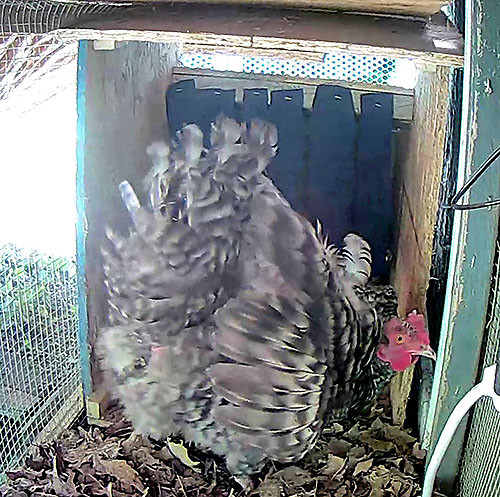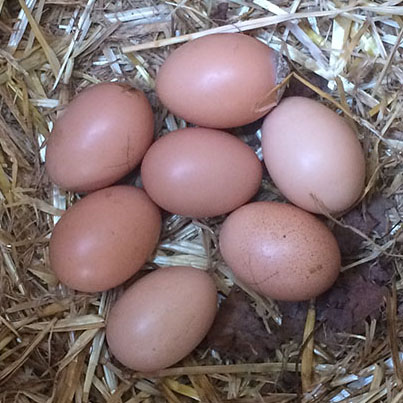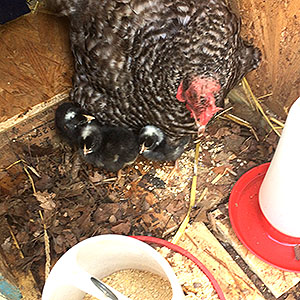Baby chicks the natural way! Incubators work fine but chicks hatched by a mamma hen is ideal for off-grid sustainability. This post is a compilation of four separate posts chronicling the adventure of the homestead’s first Boody Hen.
Some chicken breeds are prone to going broody — sitting on a clutch of eggs and hatching them. Since a hen stops laying eggs for a month or more during the broody cycle, many egg-producer breeds have had this motherhood instinct bred out of them. Barred Rocks (the homestead’s flock) are not supposed to be prone to broodiness. One of our hens decided to go broody anyhow.

“everyone, leave me alone” posture.
It all started with a “bad hair day.” One of the hens started fluffing her feathers up and screeching at her flock mates — even if they were quietly minding their own business — as if she was having a really bad-hair day. This was not her usual personality. She then started sleeping on the nest. After the second evening of shooing her off the nest, I decided to see if she was serious. She was.

Broody (her new name. Yes, I know, not very imaginative) persistently sat on a clutch of seven eggs. She could not stay sitting in one of the two nest boxes. This caused too much congestion and rancor among the other hens. I built a separate nest box with a little attached “run” so she could have a quiet place of her own.
Moving her and the eggs at night was the way to go. She complained at being handled, but pretty quickly settled down to accept her new nest.

We watched her carefully, looking for abandonment or other un-motherly behaviors. Broody, however, was a determined and faithful sitter. She would get off the nest for some food, water and a giant blaster poop — sometimes taking breaks of twenty minutes or so — before gingerly stepping back into the nest.
I positioned the broody nest near the regular coop’s run, thinking that it would be important for Broody and her flock mates to still see each other. This proved to be unnecessary and actually counterproductive. Broody only fluffed herself up and screeched at the others when she saw them. It’s a protective-mother thing, perhaps. If she goes broody again sometime, I’ll set up the broody nest someplace else. No need for visiting friends. She preferred to be alone.
Candling the eggs on the 14th night showed that all but one of the seven were developing. One was infertile and removed. Later, I broke one (clumsy me) which had a developing chick. That left five.
The Hatch

Broody’s eggs hatched on the 4th of July — 21 days from when she first started sitting. Only three of the five survived, however. The two remaining eggs (the ones I inserted late) had started to pip, but they would not survive either. (more on that below) Still, that left three healthy, fluffy chicks. Watching their first several days was an interesting introduction to mother-hen-ness.
One lesson learned:
Do not to put more eggs under a broody hen if she’s been sitting on a clutch for several days already. I did that. Thinking that the first five might have been compromised already (with Broody being chased off the nest or taking long breaks the first several days), I slipped a couple more under her as insurance. It turned out to not only be unnecessary but failure prone. The ‘new’ eggs start their clocks a few days late.
Once her first eggs hatched, Broody spent lots of time off of the nest, showing her chicks around the mini-pen. Instinct told her it was time to move on to Phase Two: Teach the chicks. The last two eggs hatched a couple days later, but it was too late. Broody was gone with her first three when the last two needed belly warmth the most.
A Second Lesson:
Eggs are not nearly as fussy as incubator instructions imply. Broody was off her eggs a lot in the first several days. Even when she was half-way through the incubation period, she would get off the nest for 20 minutes to a half an hour at a time. Maybe it was the summer heat that tided them over, but the lesson is clear. Eggs have some latitude. It seemed like Broody had an internal timer that told her when she’d been off long enough. She would return, even if in the middle of being fed treats.
Mothering Skills
Broody was a good mother. She showed her chicks where the water was. She would pull out little bits of crumble from the feeder and crunch them into tiny bits on the floor. Her chicks watched and learned to follow mom’s beak for food.
She would stand, semi-stooped for long stretches of time, like a feathered car port, so her babies could come and go beneath her. At dusk, the chicks and mamma would return to the nest. She was lay very wide and flat to ensure they were covered.

When the chicks were a week old, we let them have field trips out of the little run box and into a small fenced-off patch of backyard. Broody showed them how to scratch for bugs and to eat grass. They followed her around faithfully at first. After a few outings, they grew braver and would play apart from mom for longer and longer stretches.
It was fascinating to see instinct at work. Broody had never been a mother or raised by a mother hen. Yet, she knew just what to do and when to do it. Creation is a marvel of design.
Broody Calls it Quits
When the chicks were just over two weeks old, Broody decided she was done being a mom. She wanted to return to the adult flock. We moved the broody-nest box into the run of the half-coop as a transition. It would give them a bigger protected space.
Broody got moved back into the flock. She fit right back into the pecking order as if she had never been gone. She was completely done being a mom as if a switch had been flipped.
The chicks got a few more nights of sleeping in their nest before that was removed too. They eventually figured out flying up onto the little roost bar to sleep. Broody’s three chicks — one hen and two roosters — would grow up in the half coop.
Repeat Performance?
They say that a hen that has gone broody will be more prone to do so again. I do hope Broody will feel the motherhood urge again next year. It was pretty cool to watch and I do like the idea of nature proving the sustainable foods. Now that I have the nest box made and the small yard plot fenced off, my part of the process will go fast.
Time will tell.
